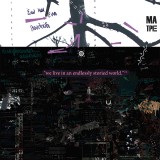The characteristic two-dimensional map of the children's room is disassembled and unfolds its third dimension. It is now distanced from its predetermined form, since the concept of depth is added, accompanied not only by 'what' but also by 'why, how and whose'. From layer to layer, the coordinates of the sense of place are encountered, looking through the kaleidoscope of personal geographies, where subjects resist oblivion as they drift, explore and record the flower in danger of being lost, in other words the ephemeral that was previously considered unmappable. The permanently in motion environment is confronted and experienced, with the idea of belonging and placement in the world dominating, not only in the present. Their diachronicity transforms the retrospective into a projection into the future, as from the Paleolithic period, Ptolemy's map, the first alternative mappings of the 1950s to the present, the maps highlight the reactionary action between environment and subject and how these countervailing forces produce narratives. The collection and encoding of experiences in space-time in a cartographic language, beyond scales and memos, using multimedia visualizations, composes a dynamic tableau, a matrix, which generates and narrates arguments and visual perceptions of the world, initiating an endless dialogue around the globe that has been transformed into a glass globe reflecting eighteen idiosyncratic cartographies, which are open to multiple readings and interpretations. Melodies, drawings, frozen frames, sensations, a little greenery, places, times and environments in motion, beyond the given.
